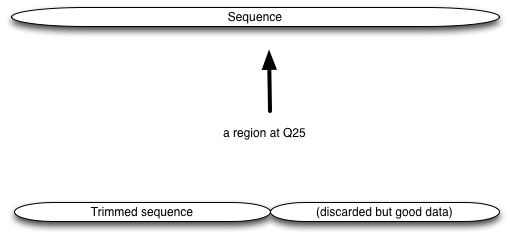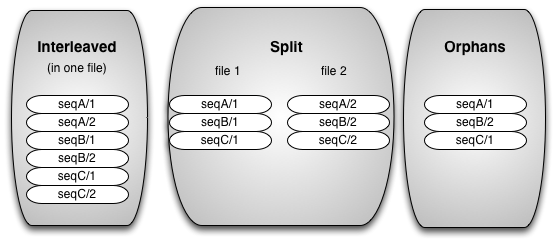Some background¶
Discussion of how Illumina sequencing works - base calling.
The Illumina machine encodes its quality information in the FASTQ format.
Quality scores are provided per base, in a log-10 scaled format. The likelihood of a base call being erroneous is 10 to the power of (-Q/10) - so for a Q value of 3, you get an error rate of 1/2, for a Q value of 30, you get an error rate of 0.001, and for a Q value of 40, you get an error rate of .0001.
Illumina typically uses a Q value of 2 to mean “ignore this base.”
It’s easy to know what to do with Ns and bad bases. But the challenge for us with Q scores is that they are statistical in nature - if we throw away every base with a Q value of 30, then 99.9% of the data we are discarding will be correct!
What do we use Illumina sequencing for?¶



In the end, the question is, what effect will losing real data have vs including spurious data, given the biological goal and the tools you have to reach it?
Basically, trimming tends to decrease sensitivity, while increasing specificity.
Basic Recommendations:¶
Always adapter trim! It doesn’t do any harm.
Impose a length filter to throw away short sequences - something like 50. This will eliminate newly-useless reads that might mismap.
- for quantification (RNAseq), trim lightly
- for RNAseq assembly, trim lightly
- for variant calling, trim stringently
...unless otherwise indicated, or if you have biological reasons otherwise.
The basic logic is that stringent trimming can remove lots of good sequence; in addition to removing actual errors.

In case it’s not clear, trimming (or not) can have real impact on your outcome –
See Questioning the evidence for non-canonical RNA editing in humans; and also Trimming RNAseq.
LICENSE: This documentation and all textual/graphic site content is licensed under the Creative Commons - 0 License (CC0) -- fork @ github. Presentations (PPT/PDF) and PDFs are the property of their respective owners and are under the terms indicated within the presentation.
